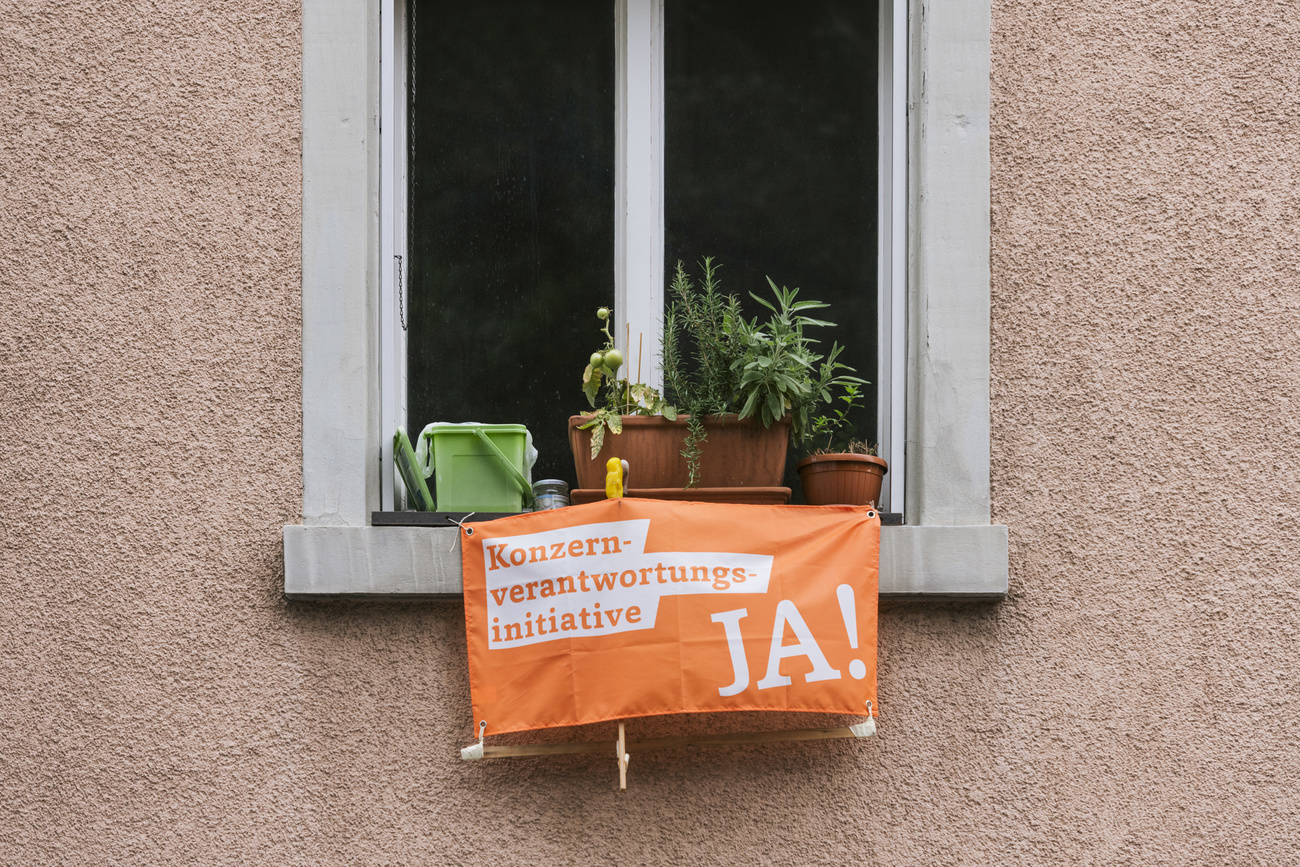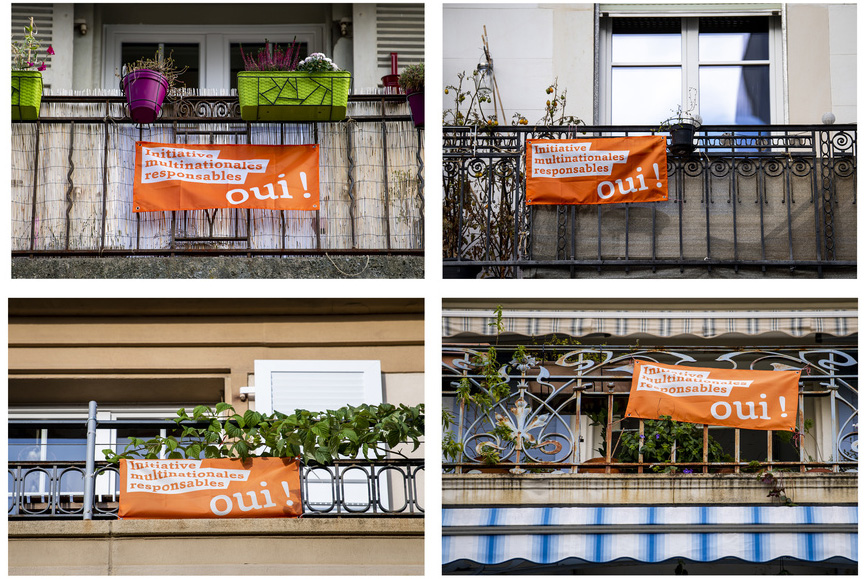The Responsible Business Initiative’s orange revolution

Backers of the responsible business vote have been highly visual in spreading their message with flags, fliers and promotional materials. Is it a new way of doing direct democracy or mere colour?
A visitor to Switzerland these days might be struck by a sense of orangeness. In towns and cities, orange flags hang from balconies and railings, triangular orange fliers are tied onto bicycle frames, orange stickers are taped onto backpacks. Even in the countryside, farmhouses and sheds carry big orange banners with the slogan “Konzernverantwortungsinitiative JA!” [Responsible Business Initiative YES!].
The initiative, which comes to vote on November 29, aims to make Swiss-based companies liable for rights abuses in their global supply chains. The flags especially are the visual centrepieces of a campaign which has taken the country by surprise, adding splashes of colour to neighbourhoods and making the people’s initiative one of the most visible of recent years. Government and parliament both oppose the idea, but latest polls suggest it could win.

Would victory at the ballot box mean vindication for the flag-hanging phenomenon? Direct correlation is hard to measure. Rahel Ruch of the organising committee says 80,000 of the flags had been sent out by early November to “all parts of the country”, both rural and urban; for context, turnout in Swiss votes is usually around 2 million. With each unit costing CHF10 ($10.95) to produce and send out – they are free for people to order – it’s a fairly cheap way of achieving wide publicity.
Their concrete impact is less clear. Some say the flags are mostly hung in neighbourhoods that are already likely to support such initiatives anyway. “Strangely, this territorial flag-displaying happens in areas where there’s nothing to be gained,” wroteExternal link one author in the Tages-Anzeiger newspaper recently. In a kind of real-world version of online echo-chambers, the flags might just highlight one’s “belonging” to a certain group or place, rather than change anybody else’s mind, the argument goes.

Mark Balsiger, a political campaign specialist, agrees that more flags doesn’t necessarily mean more votes. They are a colourful “reminder” rather than a means of persuasion, he says. However, the length of time the flags have been visible – two or three years already, much longer than the usual couple of months in the lead up to a vote – means the initiative is firmly implanted in the public’s mind. This could help mobilise supporters to cast their ballot in the coming weeks. With the battle set to be tight, “turnout is crucial”, says Balsiger.
Martin Kuenzi of the Enigma communications firm also says mere visibility is not enough, and that the second plank of any strategy is spurring people to actually vote. But he says the flags have done a fantastic job both of creating awareness and of building up a community of “fans”. This community is currently being contacted heavily by the campaign organisers, who will be giving them a last push to vote, Kuenzi says. He’s convinced the initiative will win.
Community politics
Regardless of the result, the flags seem to mark a new way of promoting an initiative: one in which supporters become campaigners, forming a vocal community around an issue. Such campaigns involve “energising a core of potential voters who have already made up their minds, so that they vote with added emotional vehemence,” as analyst Claude Longchamp wrote for swissinfo.ch in 2018.
Longchamp says the flag trend started a few years ago with the Young Socialists, who used banners to compensate the fact that they hadn’t enough money to run traditional campaigns. Today it’s spreading, and a visitor to Bern or Zurich will see hanging from balconies the stripes of the “Glacier Initiative”, a proposal to reduce Switzerland’s net carbon emissions to zero by 2050. The campaign for paternity leave also used a flag, as does an initiative to protect drinking water quality.
“It gives us visibility that we don’t have to pay for”, says Sophie Fürst, head of the Glacier Initiative campaign team. Among various promotional articles offered on this initiative’s website are T-shirts, buttons, stickers and of course the flag, made up of blue-yellow-orange stripes framing a white Alpine vista (see below). “We wanted a positively coloured flag that people could take pleasure in hanging,” Fürst says. So far, they’ve sent out around 18,000.

A new wave?
Taken at the extreme, the image of all initiatives and referendums posting out flags in future is an absurd one. Dozens of initiatives are launched each year in Switzerland; if each did it to the extent of the responsible business campaign, this would mean millions of issue-based banners strung up around the country.
Marketer Martin Kuenzi reckons it doesn’t work for all topics anyway. It works for issues that “make people proud”, he says – issues which they feel good about showing off. For an initiative, the goal is to build a movement of “ambassadors” which spreads the word on your behalf. People have to buy into it as a community, he says; don’t expect avid supporters of tax reform to start waving flags around.
Whether it could lead to polarisation or neighbourhood divisions is a bigger and vaguer question. So far, the responsible business debate has been a civil one, even if the proponents have been criticised for using doctored, and emotive, images on their vote posters (see below). But studiesExternal link have suggested that flags and symbols, while acting as a way to bring people together, can also create in-group out-group tensions. You don’t have to look far to see the tensions linked to national flags, for example.
In Bern, at least, in an apartment building in the Länggasse district known to this journalist, low-level flag wars started earlier this spring. First, a painted sheet was hung from a balcony demanding that disadvantaged groups were not left out of efforts to curb the coronavirus. In summer, as attention turned to upcoming votes, one apartment then flagged its opposition to buying new fighter jets; a downstairs neighbour responded with a patriotic-looking Swiss standard. In the end, it all led to an old-fashioned administrative intervention: a letter from the landlord, informing residents that flags were no longer to adorn the facade. Political views have since moved back indoors.


In compliance with the JTI standards
More: SWI swissinfo.ch certified by the Journalism Trust Initiative












Join the conversation!